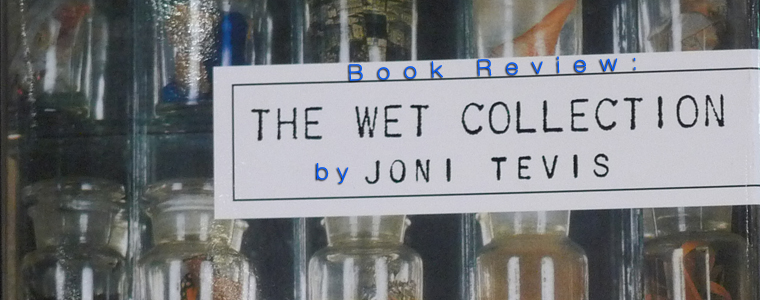Life, Curated.
by Heather M. Surls
My writing professor repeatedly gave two pieces of advice in his classes: be specific, definite, and concrete and avoid using “to be” verbs.
He had culled these from Strunk and White, which he read five times in the army and which sits on the shelf under my desk, spine cracked with use, pages marked with pencil and blue pen — the proof of multiple readings. I shape my writing by these rules, and I judge whatever I read by them.
The Wet Collection (Milkweed Editions, 2012) by Joni Tevis, a creative writing teacher at Furman University, passes with flying colors. This collection of thirty-one essays scintillates with specificity and active verbs. (Consider, for example, “Jeremiad of a Bad Drought Year,” which contains fewer than a dozen forms of “to be” in eight pages.) While Tevis’s lyricism and focus on the natural world have led some to compare her work to Annie Dillard’s, she doesn’t drown in Dillard’s fame. Rather, she splits out of Dillard’s wake in these essays, making her own waves.
In the first essay (“The Wet Collection”), which takes place in a natural history museum, Tevis presents life as a museum, a place to explore and study. This metaphor gives unity to the essays that follow, which describe past jobs, explore Tevis’s family tree, revisit vacation spots, retell biblical stories, and recreate “lost women” from brief historical references. While some of these pieces are essays in the traditional sense, with perceptible narrative lines (see “Building a Funeral,” which describes her job selling cemetery plots in Houston), others push the definition of essay. Many are composed of seemingly unrelated fragments—paragraphs of description strung together, a sort of literary scrapbooking.
Some essays — particularly the shorter ones — are more like poetry than prose, pressed thin and spare. One must read slowly, pause at the commas to absorb meaning. Consider this section from “Crescent City Beach” (one of three one-page essays in the book): “I want those claws, oval moons thralled, tied to the flipper’s near coast—rubbed stone, bone lozenge, tablet, tooth. If I hold them under my tongue, will they melt there?” Couldn’t it as easily be:
I want those claws,
oval moons thralled,
tied to the flipper’s near coast—
rubbed stone
bone lozenge
tablet
tooth.
If I hold them under my tongue,
will they melt there?
Regardless of their structure, these essays tell truth — albeit in a postmodern way. The reader is hard-pressed to find direct belief statements here, as one might find in a traditional essayist like Wendell Berry. Tevis instead relies on observation, personal experience, and description to build her arguments. She trusts the reader to stitch together the pieces of her essays, filling in the gaps with one’s own experience and thus interpreting meaning for oneself.
A possible weakness of Tevis’s oblique approach is that some readers won’t get it. Some won’t take the time to read slowly, to stop and digest. Some will fly through, catching only the descriptions — a dessert buffet, so to speak: delicious and beautiful, but lacking substance. This “weakness” is more the fault of the reader than the writer. If one comes to The Wet Collection with the willingness to slow down, to read without the bombardment of technology, one will be nourished by these essays.
This forced slowing is one of Tevis’s purposes for writing. In “The Wet Collection,” the writer meets an elderly curator at the natural history museum. “Careful study is a holy work,” Tevis writes after this encounter. “Today I’m thinking of the quiet curator, secular mystic, care her creed and discipline. In her basement room she records the mysteries we’d miss otherwise.” The essays following take the curator’s example, plunging into holy observation of plants, animals, family relationships, places, memories, and stories.
I was particularly intrigued by Tevis’s use of the Bible in her work. Moses, David, Ezekiel, and other biblical characters show up on these pages, without any intention to proselytize or give morals. Rather, drawing on a thorough knowledge of both Testaments, Tevis retells biblical stories for purely literary purposes. The reader doesn’t feel tricked when an essay suddenly turns biblical. Rather, these stories — retold from fresh perspectives and with generous reading between the lines — only add to Tevis’s intended effect in a particular piece.
As a writer, I found Tevis’s prose hypnotic. As I reread The Wet Collection in preparation for this review, I recognized her cadences in sentences I’ve written since discovering her. (For example, the comma as a backstitch — “There is something repulsive in this, these parts taken without a whole” — peppers my writing now.) In my recent work, I see the imprint of her rhythms. I didn’t realize I was so swept away; seeing these impressions startled me.
Tevis currently is writing a second book of essays, this one focusing on “ghost towns, tourist traps, and atomic dread,” according to her publisher. Until its release, hopefully in 2014, “Fairy Tales of the Atomic Age” (Orion Magazine) and “Buddy Holly, View-Master, and the A-bomb” (Diagram) will have to hold us over.
 The Wet Collection
The Wet Collection
Author: Joni Tevis
Publisher: Milkweed Editions
Date: October 2, 2012
Available at: All major booksellers
Price: $13.00 (paperback)








